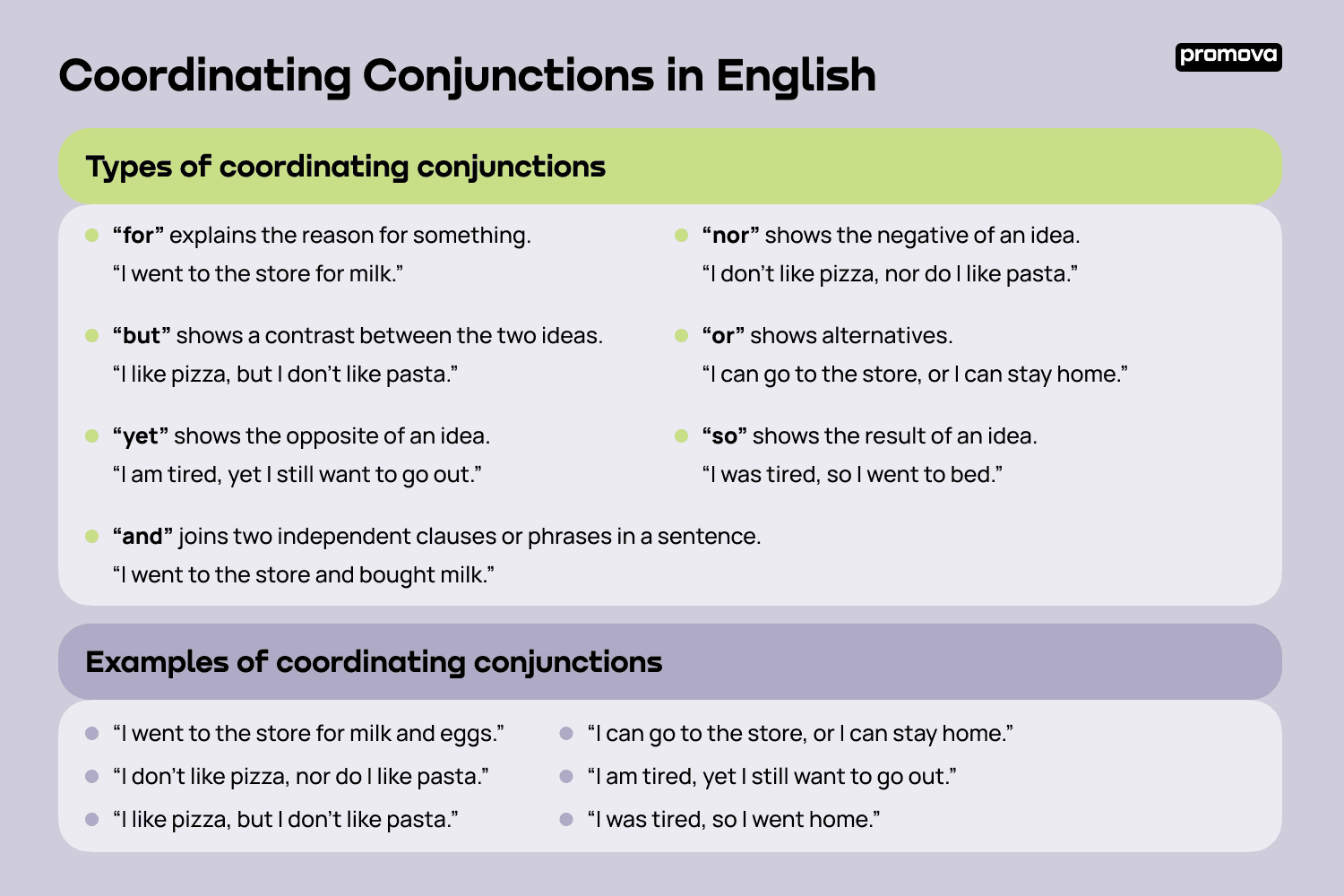Coordinating Conjunctions in English
Contents
In this reference, we will discuss what is a coordinating conjunction, types of coordinating conjunctions, examples of coordinating conjunctions in English grammar, and rules for using them in sentences. Let's get started!
What is a coordinating conjunction?
A coordinating conjunction is a type of conjunction used to join two independent clauses or phrases in a sentence. Coordinating conjunctions are also known as “coordinators,” and they can be used to join words, phrases, or clauses. The most commonly known coordinating conjunctions are “for,” “and,” “nor,” “but,” “or,” “yet,” and “so.”
Coordinating conjunctions help us create compound sentences and can be used to emphasize a point, create a complex sentence, or show a contrast between two ideas. For example, the coordinating conjunction “but” could be used to emphasize a point by saying something like “I like pizza, but I don't like pasta.” The coordinating conjunction “or” could be used to create a complex sentence by saying something like “I can either go to the store, or I can stay home.” The coordinating conjunction “yet” could be used to show a contrast between two ideas by saying something like “I am tired, yet I still want to go out.”

Types of coordinating conjunctions
There are seven main coordinating conjunctions: for, and, nor, but, or, yet, and so.
- “for” explains the reason for something. For example, “I went to the store for milk.”
- “and” joins two independent clauses or phrases in a sentence. For example, “I went to the store and bought milk.”
- “nor” shows the negative of an idea. For example, “I don't like pizza, nor do I like pasta.”
- “but” shows a contrast between the two ideas. For example, “I like pizza, but I don't like pasta.”
- “or” shows alternatives. For example, “I can go to the store, or I can stay home.”
- “yet” shows the opposite of an idea. For example, “I am tired, yet I still want to go out.”
- “so” shows the result of an idea. For example, “I was tired, so I went to bed.”
Examples of coordinating conjunctions
Here are some examples of sentences using coordinating conjunctions:
- “I went to the store for milk and eggs.”
- “I don't like pizza, nor do I like pasta.”
- “I like pizza, but I don't like pasta.”
- “I can go to the store, or I can stay home.”
- “I am tired, yet I still want to go out.”
- “I was tired, so I went home.”
1
Coordinating Conjunctions in English Grammar
In English grammar, coordinating conjunctions are used to join two independent clauses or phrases in a sentence. An independent clause has a subject and verb; it can be a complete sentence on its own. A phrase is a group of words which doesn't have a subject or a verb and cannot stand alone as a complete sentence.
Coordinating conjunctions are used to show a contrast between two ideas, to emphasize a point, or to create a complex sentence. For example, the coordinating conjunction “but” could be used to emphasize a point by saying something like “I like pizza, but I don't like pasta.” The coordinating conjunction “or” could be used to create a complex sentence by saying something like “I can either go to the store, or I can stay home.” The coordinating conjunction “yet” could be used to show a contrast between two ideas by saying something like “I am tired, yet I still want to go out.”
Rules for using coordinating conjunctions
There are some rules for using coordinating conjunctions in English grammar.
- Coordinating conjunctions can only join two independent clauses or phrases in a sentence.
- A comma is usually placed before the coordinating conjunction to separate the two independent clauses or phrases.
- Coordinating conjunctions cannot be used to join two dependent clauses in a sentence.
- Coordinating conjunctions cannot be used to begin a sentence.
Coordinating conjunctions for compound sentences
Coordinating conjunctions can also be used to create compound sentences. A compound sentence contains two independent clauses joined together.
“I went to the store for milk, and I bought eggs,”
the coordinating conjunction “and” is used to join two independent clauses.
“I like pizza, but I don't like pasta,”
the coordinating conjunction “but” is used to show a contrast between two ideas.
“I can go to the store, or I can stay home,”
the coordinating conjunction “or” is used to show alternatives.
Summary
Coordinating conjunctions are an excellent tool for expressing contrast, emphasizing a point, or creating a compound sentence. They can only join two independent clauses or phrases in a sentence and should be preceded by a comma. Now that you understand how to use them properly in English, go and make some great compound sentences!



Comments